
Another very concrete step towards the launch was taken last Friday, when the bare plywood panels were sent to Picosun Oy for coating with the ALD technology. This atomic layer deposition will put a nanometre scale thick layer of aluminium oxide on the surface of the panels, encapsulating (hopefully!) them against the conditions of space.
When looking these vacuum packed panels and seeing other parts of the satellite coming together after a hectic spring, it’s amazing to realise how many people have already been involved with the design and manufacturing of the WISA Woodsat.
Let’s have a look at the story and people so far.
The first parts for the flight model and its spare unit were made on 26 April, when the plywood used was manufactured at the UPM Plywood’s Savonlinna factory under a supervision of the mill director Tommi Takanen.
He told about the process in this video some time ago.
After that, that the plywood was cut in small pieces and sent to UPM’s laboratory facility in Lappeenranta, where it was dried in thermovacuum by the team of Kati Oinonen.

After the tests, the selected plywood pieces were sent to Jyväskylä, where they were CNC machined by Jani Nuolikoski.
He also made some of the prototype and test panels, like project manager Jari Mäkinen (in his father’s workshop in Valkeakoski) and a CNC team at UPM Plywood’s Savonlinna factory. Jani’s panels were the best and he had an honour of machining the real stuff.
As the CNC machine can’t do very small details, the panels were finished by hand by our chief engineer Samuli Nyman himself at the Arctic Astronautics laboratory in Espoo. Of course Samuli also checked that the panels were in perfect shape and exactly in precise measurements.
The panels are now in the hands of Marko Pudas at Picosun, located in Kirkkonummi, not so far from Espoo.

Some of the panels will be treated with the Temadur Clear lacquer from Tikkurila, a Nordic paint company based in Tikkurila, Vantaa. Over there the actions are taken care of by Jukka Lähde and his team.
By the end of June, these panels will meet the camera boom and related structure, and also the rails in the corners of the satellite.
The rails were manufactured by an external company and treated with a protective surfacing by Captain Corrosion in Tartu, Estonia. Captain of Captain Corrosion is Maido Merisalu, who is also behind one of the Woodsat’s science experiments.
The “selfie stick” is really a story in this story, because it turned out to be not only challenging, but also inspirational – it could have been done easier, but Kevin Vainio’s team at Huld wanted to use as little metal as possible, make the strongest possible structure with the minimal weight.
Kevin and Jaakko Kaartinen helped also to tackle other mechanical design issues with the satellite, so Huld has done in fact much more than just the camera boom.

Matti Anttila and Kimmo Kaario at Huld’s managerial level have been supporting the project and put their experience with bigger space projects in our use.
The parts designed by Huld were manufactured by Delva Oy in Hämeenlinna by Markku Lindqvist and as these additively manufactured parts have to be machined and polished, it was done by Panu Nurmilo and his company Nurmilo Oy in Pori.
And this is only the mechanical part of the satellite: we’ll cover the electronics, software and science instrument package by ESA in another blog text in future.
But still in this post we beed to thank two other persons: Paavo Heiskanen of Iceye for supervising all quality issues during the manufacturing process, and Markus Hotakainen from Puuksio for making the first ever models of the wooden satellites, including the very first one in 2017 that in a way proved that the idea wasn't totally crazy.
More photos are available in our new Flick account.
